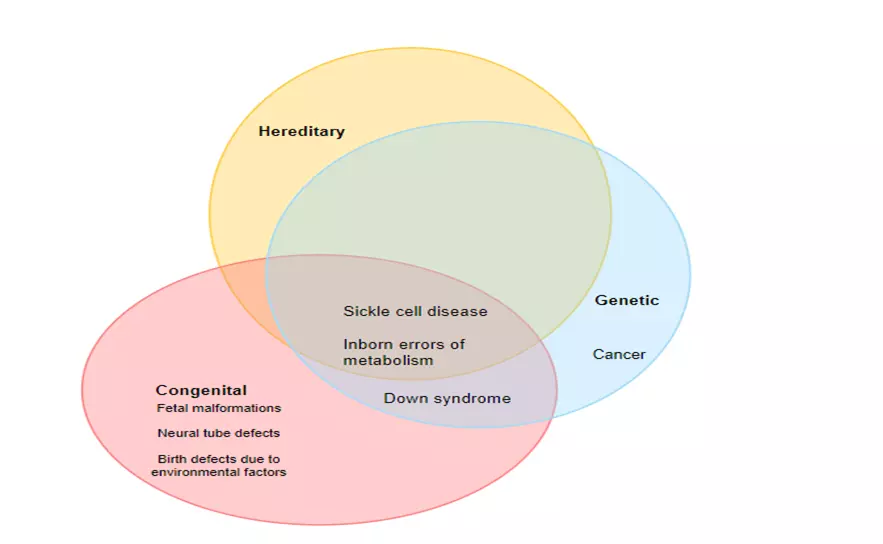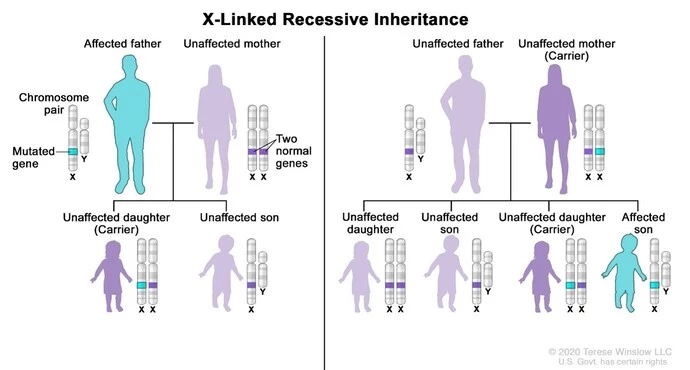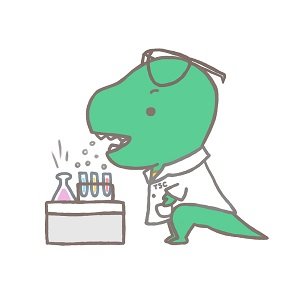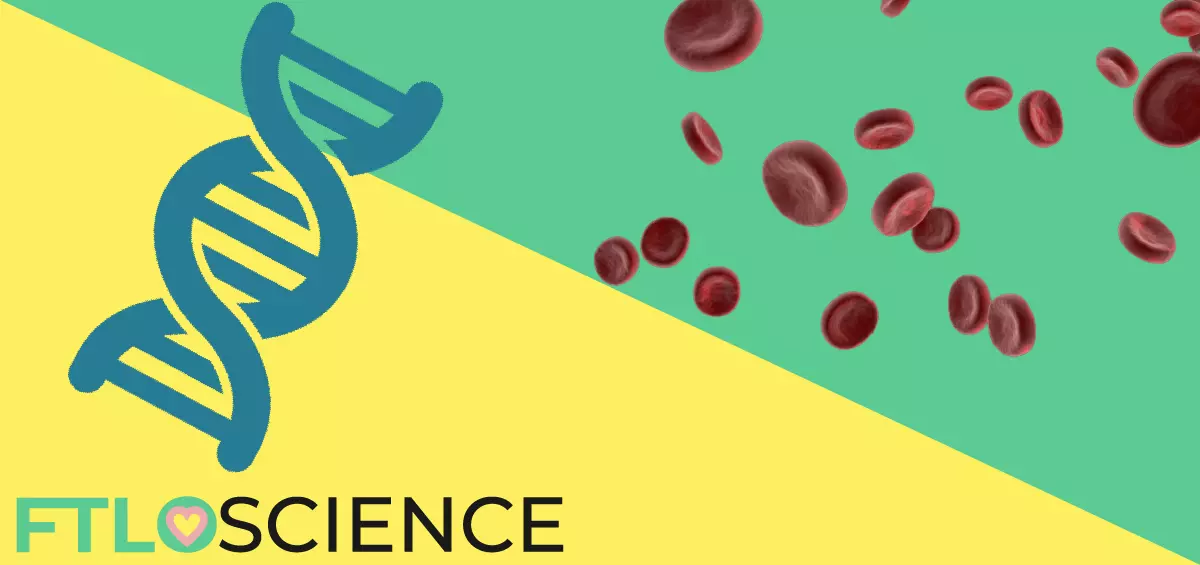We often confuse hereditary, congenital and genetic disorders with each other, using these terms interchangeably to describe diseases. How can we correctly classify these disorders? We break down the differences between these medical jargon and how to tell them apart.
Let’s first understand them separately:
- Hereditary disorders: Disorders that have the potential to be passed down from one generation to another.
- Congenital disorders: Conditions that have been present since birth.
- Genetic disorders: Diseases caused in whole or in part by mutations in the genome.
A genetic disease can also be hereditary and congenital. Hereditary diseases, however, are always genetic (since genes are passed down from one generation to another). Congenital diseases are not necessarily genetic, but they can be.
Breaking Down the Jargon
Genetic Diseases: Hereditary Vs. Non-Hereditary
Let’s understand this with some examples: In a genetic disease, there will always be some alteration (mutation) in the genome; however, this mutation can either be inherited from the parents or acquired.
For instance, sickle cell disease is a blood disorder that a child is born with (it is congenital). It is inherited when a child has two sickle cell genes, one from each parent. Mutations occurring in the genome are transferred from one generation to another. Therefore, sickle cell disease is both a hereditary genetic disorder.
Now let’s look at non-hereditary genetic disorders. As in the case of cancer, mutations occur in the genes that control the growth and multiplication of cells; however, cancer itself cannot be passed down.
Congenital Diseases Hereditary Vs. Non-Hereditary
Hereditary congenital disorders are caused by genetic defects. i.e., chromosomal abnormalities (trisomy 21 or Down syndrome) and single gene defects (cystic fibrosis). Various metabolic disorders caused by a gene defect are inherited and are clinically evident at birth (commonly termed inborn errors of metabolism). The chance of a baby having an Inborn Error of Metabolism is 1 in every 4500 babies.
What about congenital diseases that are not hereditary? Certain fetal disorders and malformations occur due to exposure to teratogenic (toxic to unborn children) agents and other environmental factors, including infections. For example, certain heart defects and neural tube defects are caused by viral infections. Since they are not inherited through genetic defects, they are non-hereditary congenital disorders.

How Hereditary Conditions are Passed Down
Chromosome Pairs from Parents
Each cell of the human body contains 23 pairs of chromosomes, which contain the genes necessary for survival. Of these, 22 pairs are identical in males and females and are termed autosomes. The 23rd pair comprises the sex chromosomes and determine the gender of the person.
Females have two copies of the X chromosome (XX, one from each parent), while males have one X chromosome (from the mother) and one Y chromosome (from the father). Each chromosome consists of hundreds to thousands of genes, and defects in these genes may lead to genetic disorders.
Based on the type of chromosomes involved, the inheritance of genetic disorders may be:
- Autosomal (to do with autosomes, i.e., chromosomes other than sex chromosomes)
- Sex-linked (as most of them are associated with the X-chromosome, they are generally termed X-linked)
- Dominant and recessive: these can be broken down into dominant or recessive modes of inheritance, which we will explain further below.
Some other rare modes of inheritance also exist, for example, mitochondrial inheritance.
Autosomal Dominant Inheritance
While our genes comes in pairs, only one copy of a faulty gene is enough for autosomal dominant disorders to cause disease. These diseases tend to occur in every generation of a family.
Each affected person usually has one affected parent. Some examples are Huntington’s disease, familial hypercholesterolemia, and achondroplasia.
Autosomal Recessive Inheritance
In this case, both copies of the mutated gene are required for disease manifestation for recessive diseases. Recessive genetic disorders are typically not present in every generation of an affected family.
The parents are generally carriers and pass the same mutated gene to the affected child. Examples include Tay-Sachs disease and phenylketonuria.
Sex-Linked Dominant Inheritance
For sex-linked dominant diseases, a single copy of a faulty X-linked gene will cause disease in both males and females.
Families with an X-linked dominant disorder often have both affected males and affected females in each generation. Vitamin D-resistant rickets is inherited in such a manner.
Sex-Linked Recessive Inheritance
The hereditary pattern differs among males and females for sex-linked recessive diseases. Since females have two copies of each X-linked gene, both copies must be mutated for disease manifestation.
On the other hand, males only have one X chromosome, so a single copy of the mutated X-linked gene will result in disease manifestation (as a second one is not present to mask the condition).
Families with an X-linked recessive disorder often have affected males but rarely affected females in each generation. Females are generally carriers with one copy of the mutated gene but are otherwise clinically normal. One crucial example is Duchenne muscular dystrophy.

Examples of Rare Hereditary Disorders
Hutchinson-Gilford Progeria Syndrome
Hutchinson-Gilford Progeria syndrome, or simply Progeria, is a rare genetic disease characterized by accelerated aging due to cumulative cellular damage. It is caused by a mutation in the LMNA gene that affects approximately 1 in 20 million.
There have been many movies based on Progeria, such as ‘The Curious Case of Benjamin Button’ and ‘Life According to Sam’.

Marfan Syndrome
Marfan syndrome is a genetic disorder caused by a mutation in the gene coding for fibrillin-1, a connective tissue protein. This protein is required for holding the cells, organs, and tissues together.
Individuals with this syndrome are usually tall and thin, with elongated, thin arms and legs, loose and very flexible joints, and a small lower jaw. It has been suggested that Abraham Lincoln, the 16th President of the United States of America, suffered from Marfan syndrome.

SCID: Bubble Boy Syndrome
Severe Combined Immunodeficiency (SCID), commonly known as ‘bubble boy syndrome’ is a group of disorders characterized by impaired or absent immune function. This results in frequent, recurring infections with microorganisms. Infections that are minor in most people can be life-threatening in people with SCID.
David Vetter, a young boy from Texas, was a prominent sufferer of SCID. He spent all 12 years of his short life in a sterile plastic bubble to avoid exposure to infectious organisms, gaining media attention as ‘David, the bubble boy’.

Developments in Genomic Techniques
Genomic techniques have allowed the identification of many genetic mutations associated with diseases. From the diagnostic point of view, there has been a paradigm shift due to the introduction of next-generation sequencing (NGS). Sequencing of the entire genome and sets of genes associated with diseases can be performed.
Gene therapy remains an area of research interest as a therapeutic approach for genetic diseases. It involves inactivating the defective gene or replacing it with a functional gene.
Clinical trials on gene therapy have shown some success in the treatment of a few diseases, such as sickle cell anemia, leukemia, some forms of severe combined immunodeficiencies, spinal muscular atrophy, and hemophilia. Gene therapy holds tremendous potential; in time to come, an increasing number of patients will undoubtedly benefit from the technology.
This article was written by Dipti Tiwari via Write For Us.
About the Author

This article was written by a contributor. For a full list of guest writers, click here.




